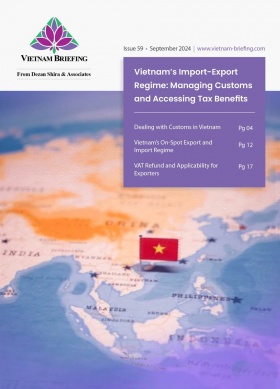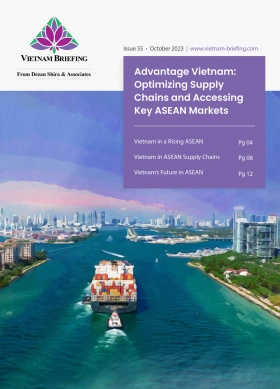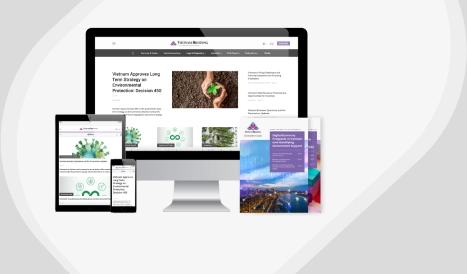Hanoi Master Plan 2045-2065: Major Goals and Investment Prospects
With ambitious adjustments to its 2045-2065 Master Plan alongside the Capital Region Transport Master Plan 2030–2050, Hanoi aims to be a leading urban hub in Southeast Asia and beyond. The city’s authorities plan to balance infrastructure modernization with sustainability, establishing the Hanoi metropolis as a model for global connectivity and green development.
Hanoi is charting a bold course to become a globally connected metropolis by 2045 under the recently approved adjustments to its master plan. Decision No. 1668/QD-TTg, signed by Deputy Prime Minister Tran Hong Ha, outlines a vision for the capital city to achieve world-class living standards and rival the capitals of developed nations in the region and beyond.
According to government data, Hanoi’s budget revenue surpassed 501.6 trillion VND (US$20.9 billion) by the end of December 2024, marking the first time it crossed the 500 trillion VND milestone.
Hanoi’s Master Plan 2045-2065: Key objectives
Vision to develop a modern urban landscape
Covering an area of approximately 3,359 square kilometers, Hanoi consists of 30 administrative units and 579 commune-level administrative units. By 2030, the city aims to position itself as a modern urban hub, integrating regional and international services, while becoming a sought-after economic and cultural destination.
Looking ahead to 2045, Hanoi plans to transform into a smart and ecological city, serving as a financial, service, science-technology, and human resource training hub. The city also envisions hosting major political, economic, cultural, and scientific events on the global stage.
Hanoi’s future hinges on becoming a green, secure, and happy city, fostering sustainable growth to drive the Red River Delta and the northern key economic region.
Hanoi’s expected population growth and land use
Hanoi’s population is expected to reach 12 million by 2030, including 10.5 million permanent residents. By 2045, this number will grow to 14.6 million, with 13 million permanent residents. The city master plan forecasts an increase in construction land, with urban land expanding to 125,000 hectares by 2045 by ‘balancing modern infrastructure along with ecological preservation’.
Three new cities, each with a distinct focus
Hanoi’s master plan for 2045-2065 outlines the development of three new cities within its administrative boundaries, each serving specific economic, social, and environmental purposes:
- Northern City
Located in Dong Anh, Me Linh, and Soc Son, this city will leverage its proximity to Noi Bai International Airport to become a modern, smart urban hub. It will complement Hanoi’s central areas by prioritizing green, clean, and innovative industries. Key initiatives include international-standard entertainment complexes, diverse commercial services, and a thriving nighttime economy. - Western City
Focused on Hoa Lac, Xuan Mai, and Son Tay, the western city will be a center for science, technology, and high-quality education. It will also promote cultural tourism and ecological services, positioning itself as a regional hub for scientific advancement and sustainable development. - Southern City
Encompassing Thuong Tin and Phu Xuyen, the southern city will specialize in public services, logistics, and industrial support. Industrial zones in Phu Xuyen will facilitate the relocation of manufacturing from inner-city areas, transforming the region into a logistics hub and strengthening its connectivity with nearby provinces such as Ha Nam.
Multi-centric urban zones
The master plan designates Hanoi as a multi-centric urban region, structured around five distinct zones:
- Southern Red River Urban Zone: Encompasses the historic inner city, its expanded areas, and urban developments extending westward and southward into Dan Phuong, Hoai Duc, Ha Dong, Thanh Tri, and parts of Thanh Oai and Thuong Tin.
- Eastern Urban Zone: Includes Long Bien and Gia Lam districts.
- Northern Urban Zone: Covers Dong Anh, Me Linh, and Soc Son districts, with future plans to establish a Northern City.
- Western Urban Zone: Comprises Son Tay town and the districts of Ba Vi, Phuc Tho, Quoc Oai, Thach That, and Chuong My, with plans to upgrade Son Tay town into a city and develop a new urban area.
- Southern Urban Zone: Consists of the districts of Thanh Oai, My Duc, Ung Hoa, Thuong Tin, and Phu Xuyen, with studies underway to form a city in this southern region.
Enhancing the night economy and tourism
The adjusted master plan emphasizes developing a vibrant night economy, integrating modern trade and tourism. Hanoi’s central urban areas will host commercial-service hubs, organized shopping streets, and expanded pedestrian zones. Key river corridors—such as the Red, Duong, and Day rivers—will anchor tourism projects, with recreational parks, theme parks, and comprehensive visitor services enhancing the city’s cultural allure.
Healthcare transformation
Hanoi aspires to become a leading national healthcare hub by leveraging world-class technological advancements and integrating medical services with healthcare tourism and wellness retreats. Up to 700 hectares of land will be allocated for hospital construction. Specialized hospitals and medical complexes will be established in satellite urban areas to deliver advanced healthcare services.
The city plans to expand both public and private healthcare centers in satellite cities, ecological urban areas, and towns to cater to local communities’ healthcare needs.
Land will also be set aside for medical complexes that serve Hanoi and its surrounding regions. Existing hospitals and healthcare facilities in the inner city will undergo upgrades to meet modern standards and continue serving the population.
Facilities for treating high-risk infectious diseases will be relocated outside central urban areas to ensure public safety. Furthermore, land will be allocated for the development of high-quality research, training, and medical treatment centers.
Addressing flood management
Flood mitigation and water resource management are critical components of the master plan. Efforts will include restoring the Red River’s main channel and improving drainage systems like the To Lich River. These measures aim to enhance urban resilience and ensure sustainable development.
Hanoi’s ambitious railway upgrade plans – 2035 to 2065
Hanoi has outlined a transformative vision for its public transportation system, aiming to complete over 410 kilometers of urban railway by 2035 and expand to a total network of 15 lines spanning more than 616 kilometers by 2065. This ambitious project is set to modernize the city’s transit infrastructure, catering to the growing demands of its residents and bolstering economic development.
Under the Capital Region Transport Master Plan 2030–2050, aligned with the broader Hanoi Capital Development Plan 2045–2065, Nguyen Phi Thuong, Director of Hanoi’s Department of Transport, shared the following strategies to be adopted:
- Streamlined Approvals and Funding Mechanisms:
- Special policies for land acquisition, compensation, and resettlement to accelerate project timelines.
- Public investment prioritization, supplemented by public-private partnerships (PPP) to reduce state budget dependency.
- Standards and Workforce Development:
- Establishing sector-specific standards for urban railway construction.
- Training a skilled workforce to manage the growing system.
- Technological Advancements and International Cooperation:
- Leveraging modern technologies to enhance efficiency.
- Collaborating with international consultants for high-quality project execution.
Opportunities for foreign investment in Hanoi’s development plans
Hanoi’s master plans demonstrate a commitment to sustainable growth and global connectivity, making it an attractive destination for foreign investors looking to play a pivotal role in the city’s transformation within the dynamic ASEAN region.
Looking to the future, Hanoi’s authorities are focused on sustainability, technological integration, and infrastructure development – offering a promising landscape for businesses to contribute and benefit. Below are key areas of potential investment:
Urban infrastructure and smart cities
Hanoi’s goal of becoming a smart, ecological city by 2045 requires advanced urban infrastructure. Foreign investors can participate in:
- Smart city technologies: IoT solutions, traffic management systems, and smart utilities.
- Sustainable construction: Eco-friendly building materials and energy-efficient designs for urban projects.
Public transportation and railway development
Hanoi’s plan to develop 15 urban railway lines totaling over 616 kilometers by 2065 opens opportunities in:
- Railway construction: Joint ventures for design and development of new lines.
- Technology integration: Advanced signaling systems, automation, and smart ticketing solutions.
- PPP: Co-investment in railway expansion projects.
Healthcare and medical tourism
With plans to allocate 650–700 hectares for hospitals and medical complexes, the healthcare sector is primed for foreign investment in:
- Hospital infrastructure: Establishment of specialized medical centers and research facilities.
- Healthcare technology: AI-driven diagnostics, telemedicine platforms, and advanced medical equipment.
- Medical tourism: Development of wellness retreats and integrated healthcare-tourism services.
Tourism and the night economy
The emphasis on enhancing Hanoi’s night economy and tourism sector presents opportunities in:
- Hospitality: Construction of luxury hotels, resorts, and serviced apartments.
- Entertainment: Development of theme parks, cultural attractions, and riverfront recreational areas.
- Retail: Establishing international shopping centers and pedestrian-friendly commercial zones.
Flood management and environmental services
Flood mitigation efforts, including the restoration of the Red River’s main channel, offer investment prospects in:
- Water resource management: Advanced drainage systems and flood control technologies.
- Environmental consulting: Sustainable urban planning and climate resilience strategies.
Technology and human resource development
As Hanoi positions itself as a regional science-technology hub, foreign firms can invest in:
- Tech parks and innovation centers: Establishing R&D facilities and incubators.
- Training programs: Collaborating with local institutions to develop a skilled workforce.
Renewable energy and sustainability
The city’s emphasis on green growth aligns with opportunities in:
- Solar and wind energy: Development of clean energy projects to power urban expansion.
- Energy efficiency solutions: Retrofitting existing infrastructure for reduced energy consumption.
Real estate and urban development
- The expansion of multi-centric urban zones provides opportunities for residential projects and mixed-use development – if aligned with government objectives – such as high-rise apartments and gated communities and commercial complexes combining office spaces, retail, and leisure facilities.
About Us
Vietnam Briefing is one of five regional publications under the Asia Briefing brand. It is supported by Dezan Shira & Associates, a pan-Asia, multi-disciplinary professional services firm that assists foreign investors throughout Asia, including through offices in Hanoi, Ho Chi Minh City, and Da Nang in Vietnam. Dezan Shira & Associates also maintains offices or has alliance partners assisting foreign investors in China, Hong Kong SAR, Indonesia, Singapore, Malaysia, Mongolia, Dubai (UAE), Japan, South Korea, Nepal, The Philippines, Sri Lanka, Thailand, Italy, Germany, Bangladesh, Australia, United States, and United Kingdom and Ireland.
For a complimentary subscription to Vietnam Briefing’s content products, please click here. For support with establishing a business in Vietnam or for assistance in analyzing and entering markets, please contact the firm at vietnam@dezshira.com or visit us at www.dezshira.com
- Previous Article Vietnam’s New Trade Union Law: Key Changes and Foreign Workers’ Rights
- Next Article Vietnam’s Economic Report Card for 2024: GDP, Trade, FDI








